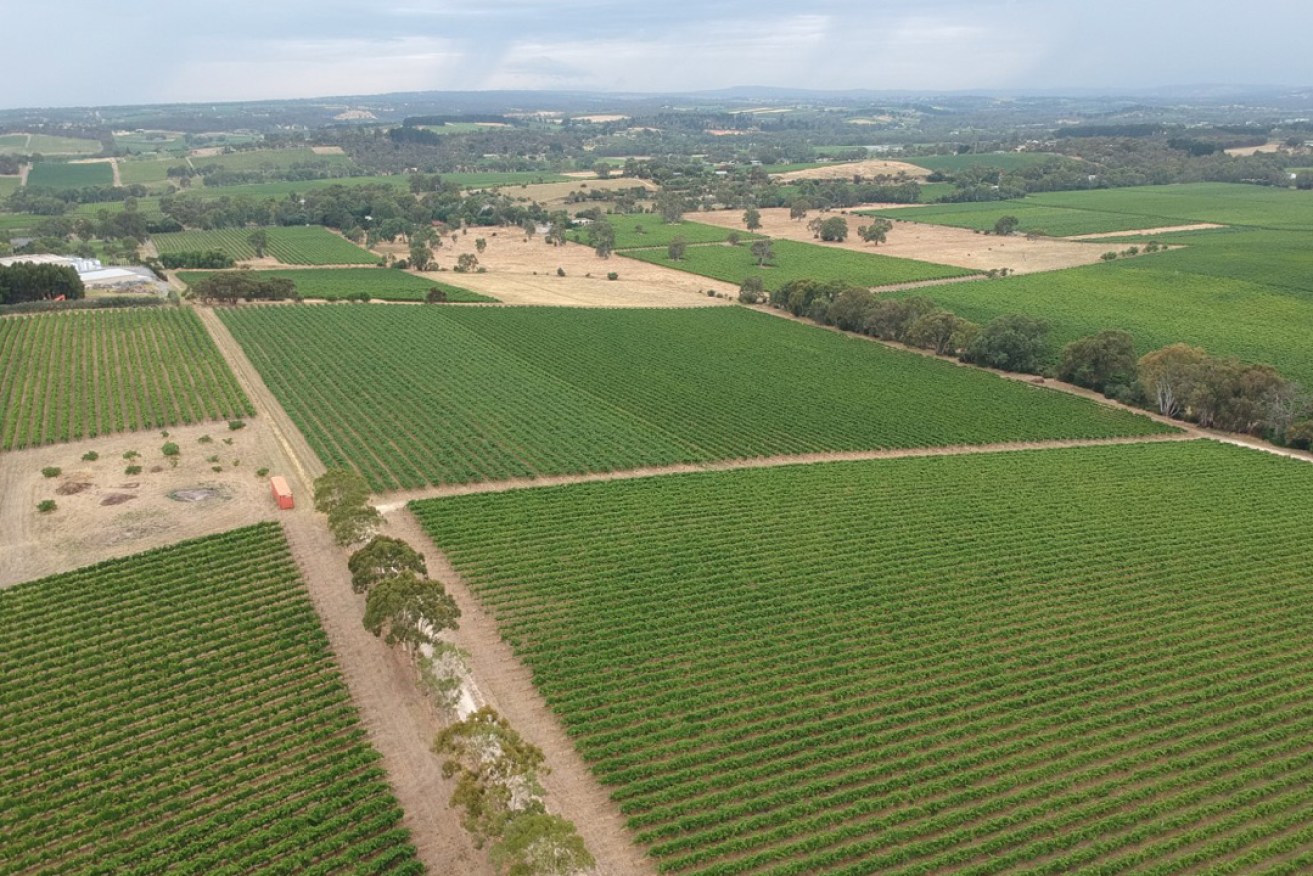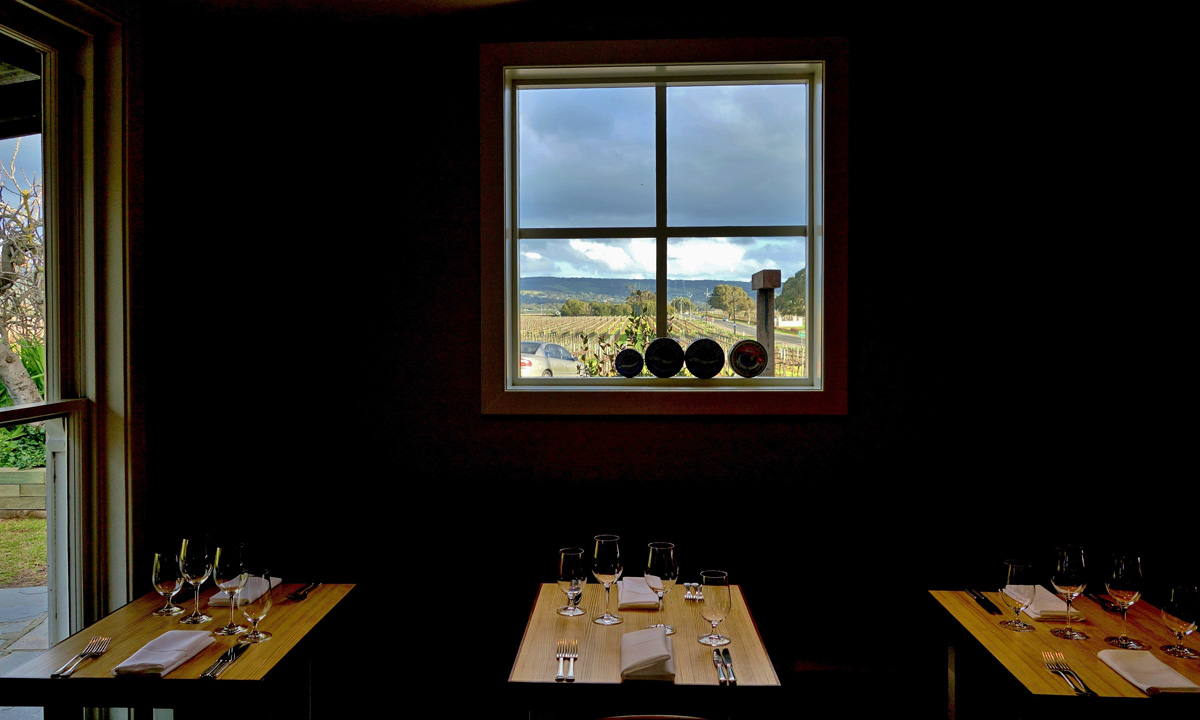No future in this smoky planning atmosphere
Philip White ponders the long-term future of McLaren Vale, the vignoble he loves enough to live in.


The Hut Block, alongside the popular Willunga bicycle and hiking track east of The Salopian on McMurtrie Road. Photo: supplied
During the California bushfires, it was too easy to be judgmental of a famous photo taken of big American men in cargo pants and loafers, casually playing golf while the mountain next door burned down.
I thought of this on Sunday, sitting in the shade with an exquisite wood-oven pizza and a glass of cold Greco at Sellick’s Hill Wines. There we were in the vineyard on the piedmont, looking down over the McLaren Vale vignoble, which was draped in bushfire haze. A queue of water-bombers buzzed over us on their trips to refill at the Aldinga airport before heading back along that beautiful coast to dump it on the Carrickalinga fire.
These little inconveniences are best left to the experts. Lunch was good.
Gazing over the bonnie embayment I call home, I couldn’t help wondering about the experts in charge of the place. Those responsible for planning its future. Its style; its look; its purpose.
Like there in the gentle hollow below us lay that contentious airport, desperately essential on days like that, but otherwise busy with light planes coming from the bush for a service and annoying enough to drive good winemaking neighbours like Susana Fernandez and Duncan Ferguson to sell their highly-regarded Cascabel winery and vineyards and move to Tasmania.
The vineyards, like Cascabel, produce remarkable fruit on the Kurrajong Formation, complex rubble washed down across the Willunga Fault from the mountains which have nearly worn away. The wines of Rudderless, Sellicks Hill, Cradle of Hills, Danshi Rise, Battle of Bosworth, Marius, Noon’s, The Hedonist and Gemtree come largely from this fine higher ground. Wineries further away, like Penfolds, Coriole and Stephen Pannell, seek it out: Penfolds and Coriole have planted new vineyards there near Willunga.
Below that narrow strip of geology lies what I call The Wok: around that airport in the basin of hard black cracking clay there are many vineyards growing fruit which is so hard to sell it’s often left unpicked. Then the growers can’t afford to prune or spray, so their tangled vineyards work as incubators for various funguses and bugs that spread to better vineyards on higher ground.
That hollow must have been a lush swampy bushland teeming with life before it was cleared. There’s a great example of that pristine world miraculously left in the Aldinga Scrub at the coast, which people love to live beside, and walk in. It’s packed with birds, echidnas and roos.
I’ve often thought that the scrub should be encouraged to regrow in a band across that hard clay basin, all the way up past the airport to the Willunga township. Let the swamps reoccur, open the watercourses and plant trees. Pay the landowners to repurpose their ground, or simply buy it from them.
Spread at various sites through this new growth a string of micro-villages could be built. Imagine a circle of two or three-storey terrace houses facing into a common garden in the bush. Vehicle access would be outside, as it is at the far-sighted rammed earth village the visionary Ian Collett built at Willunga. Beneath the verandahs in the courtyard could be a coffee shop, an eatery, a haircutter, a bakery … little villagey businesses. Bike trails. Discrete laneways.
Bacchus knows, if there’s no room to build a new resort within the town boundaries of McLaren Vale, McLaren Flat or Willunga – or at the beach, dammit – you might even hide one in your new bushland.
There are some damned fine tree planters in McLaren Vale. Witness the reforestation of the escarpment. When we began work – two writers, four photographers and a printer/designer – on the book McLaren Vale – Trott’s View at the turn of the millennium, there was hardly a tree on that range of what Trotty called “those gentle feminine folds”. To compare those bare photographs to today’s vista is pretty much black-and-white: the hills face is now healthy with reforestation, done mainly by volunteers.
The bushfires are partly the result of climate change. As the Californians know all too well: things are getting hotter. Inland vignobles are discovering this all too quickly: vineyard dressing, water resources, the grape varieties chosen are all matters of reactive flux and contention.
While McLaren Vale sits right on the tempering Gulf St Vincent, and its vineyards take recycled water from the seaside suburbia, it would seem likely that this district may have a smoother future than hotter, drier regions. But those vineyards in The Wok will always struggle. If the vignoble is to remain at its current vast scale, smart growers will be forced to look at planting the higher, damper, cooler ground of that largely reforested escarpment to survive.
These are very big changes. They need visionary planners. We need to talk.
It’s now six years since the Barossa and McLaren Vale Character Preservation legislations were passed. In those years, it seems very few folks have actually done much planning other than environmentally-aware locals reacting to developers keen to test the limits of these admirable and essential laws.
So far, these instances have been minor, but they’re continual. And now we have, in this region at least, the first real Big One: a perfect example of how the legislations, in their determination to stop inappropriate development of such prime and famous agricultural land to keep it alluring to tourists, have set tourism against the very agriculture, the viticulture, the nuts-and-berries wine culture that attracts the visitors in the first place.

The reforestation of the Willunga Escarpment provides a healthy vista from The Salopian Inn. Photo: Philip White
If you leave the McLaren Vale township and take a left onto McMurtrie Road at The Salopian Inn, you’re into seriously valuable vineyard country. Along this road you find the refined and hospitable tasting cellars of Primo Estate, Hugh Hamilton, Mitolo and Wirra Wirra. These tasteful businesses are hardly a blight.
But close to Salopian, where the busy bike trail crosses McMurtrie Road, lies the respected Hut Block of Hugh Hamilton’s brother, Richard, the surgeon who owns Leconfield Wines. Before Christmas, an application was lodged with the pro-development Onkaparinga Council to build a resort on this gentle, but dominant slope. This will include 150 five-star hotel rooms, two restaurants, a café, an indoor swimming pool, a gymnasium, a day spa, conference facilities and a two-storey carpark.
As this prime vineyard block runs right through to the back side of the big Serafino winery/conference/restaurant/motel complex on the township’s boundary, the proposal would push the built form of McLaren Vale a significant distance into the vineyards the Character Preservation legislation was intended to protect.
The Character Preservation laws were largely triggered by the development of Seaford Heights, an ugly gutter-to-gutter suburb at the west end of McLaren Vale’s main street. The locals didn’t want it, and mounted an ongoing campaign to stop it, including the much-publicised Tractor Action, when farmers blocked the roads with their machinery.
When Planning Minister John Rau – also the Attorney-General – came to town to tell us the development would go ahead, the approval seemed generally regarded as a downpayment, a loss in exchange for the major win: the legislation which we presumed would prevent anything like this from ever happening again.
Now we have this new “tourism” proposal at the other end of the village, again outside its surveyed boundary. The developers have since withdrawn their initial plan; council has advised there’ll be a new application made. They’re determined.
So there sat your writer, eating pizza, drinking wine, looking across The Wok at this site in the highly profitable vineyards around the village. I wasn’t playing golf in the face of the fire, but I became very aware that far too many of us have been eating, drinking and golfing, thinking the job was all done, while we should have been addressing the long-term future of the district we love.
It seems stuff of such weight can’t be left to the experts.
drinkster.blogspot.com




